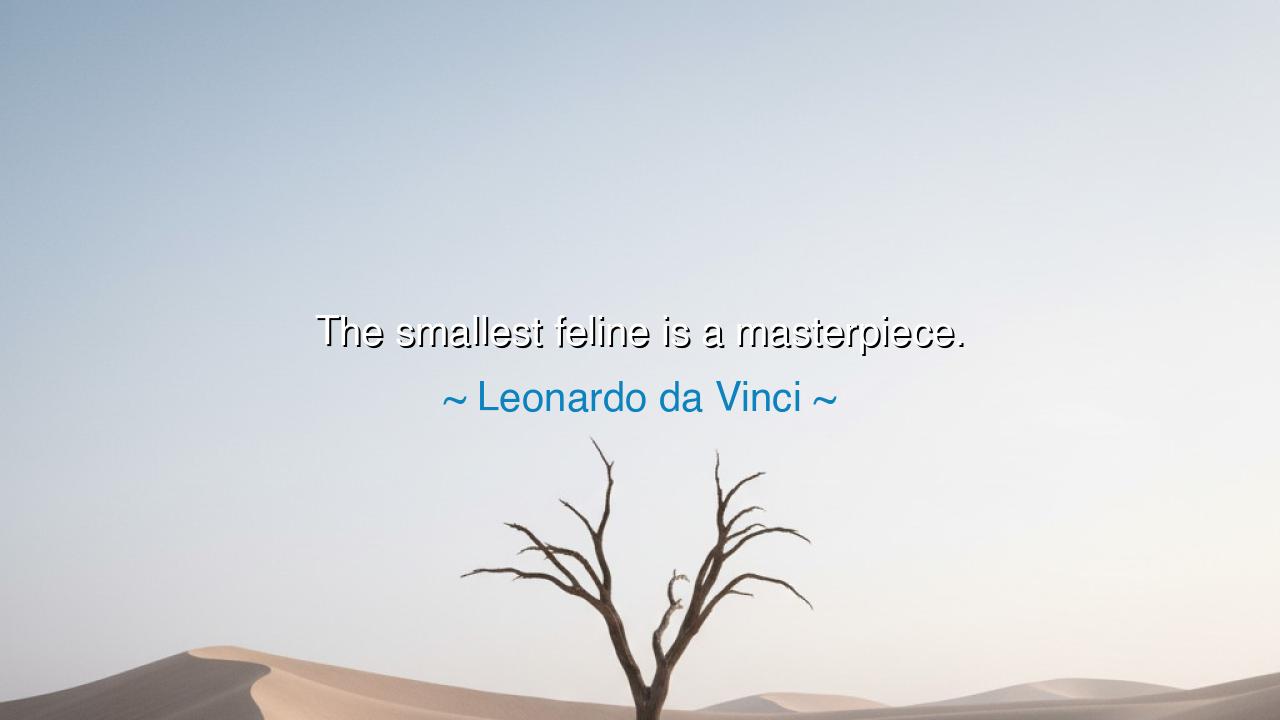
The smallest feline is a masterpiece.






Leonardo da Vinci, master of both art and science, once declared with reverence: “The smallest feline is a masterpiece.” These words, though spoken of a humble creature, are in truth a hymn to creation itself. For in the feline—the delicate arch of its back, the silent grace of its step, the sharp gleam of its eye—he saw not merely an animal, but the perfection of nature’s design. In this, da Vinci revealed the depth of his vision: that true beauty is not measured by size, grandeur, or power, but by harmony, proportion, and mystery.
To call a feline a masterpiece is to say that every living being, however small, carries within it the signature of divine artistry. A cat’s leap, silent yet precise, embodies both strength and elegance. Its fur, soft as whispering winds, conceals the hunter’s claw and the survivor’s resilience. In its stillness there is mystery; in its movement, poetry. Da Vinci, who studied the flow of rivers, the flight of birds, and the structure of muscles, recognized in the cat the union of form and function so perfect that it rivaled the greatest works of human hands.
Consider the civilizations that revered the feline. In ancient Egypt, the cat was no mere pet, but a sacred symbol of protection, fertility, and grace. The goddess Bastet, lioness and cat, was worshiped as a guardian of home and life. To harm a cat was to commit sacrilege, for the people saw in it something eternal, something crafted beyond mortal understanding. Da Vinci’s words echo this ancient truth: that to study the smallest creature is to glimpse the wisdom of the cosmos.
History offers us countless proofs of this vision. Take, for instance, the naturalists who later followed Leonardo’s path—Charles Darwin among them. When Darwin observed the balance of ecosystems, he noted how even the presence of cats in a village could shape the fate of crops and communities. The cat, small as it seemed, kept rats at bay; rats, if unchecked, would consume grain; the grain sustained families. Thus, in the smallest feline, entire chains of life were preserved. What da Vinci saw as aesthetic wonder, Darwin saw as ecological truth. Both proclaimed: even the small carries immeasurable weight.
Yet this saying is not only about cats. It is about the philosophy of wonder. In an age where men chase greatness in vast monuments and colossal deeds, da Vinci turned our eyes toward the subtle, the quiet, the overlooked. He whispered that a single creature, purring softly by the fire, holds as much grandeur as the domes of cathedrals and the strokes of frescoes. If we cannot see the masterpiece in the cat, how shall we ever recognize the masterpiece in ourselves, or in the smallest details of life?
The lesson for us, then, is one of attention and reverence. To live wisely is to marvel at the small: the curve of a leaf, the laughter of a child, the silence of dawn. In admiring the smallest feline, we train our souls to perceive the sacred in what others dismiss as ordinary. Such vision strengthens humility, sharpens gratitude, and brings peace to restless hearts.
Practically, we must cultivate the eye of Leonardo. Slow your steps. Watch the creatures around you—observe how they live in harmony with their nature. Instead of seeking greatness only in distant triumphs, find it in the details near at hand. If you live with a cat, study its patience, its presence, its acceptance of both solitude and companionship. Let its grace remind you that mastery is not noise, but balance; not excess, but essence.
So remember the words of the master: “The smallest feline is a masterpiece.” Do not pass by lightly what the universe has crafted with infinite care. For if such perfection resides in a creature so small, how much more beauty lies hidden in the vast tapestry of life—and within your own being? Train your eyes to see, and your heart will never again live in poverty, for every moment will become a gallery of wonders.






AAdministratorAdministrator
Welcome, honored guests. Please leave a comment, we will respond soon